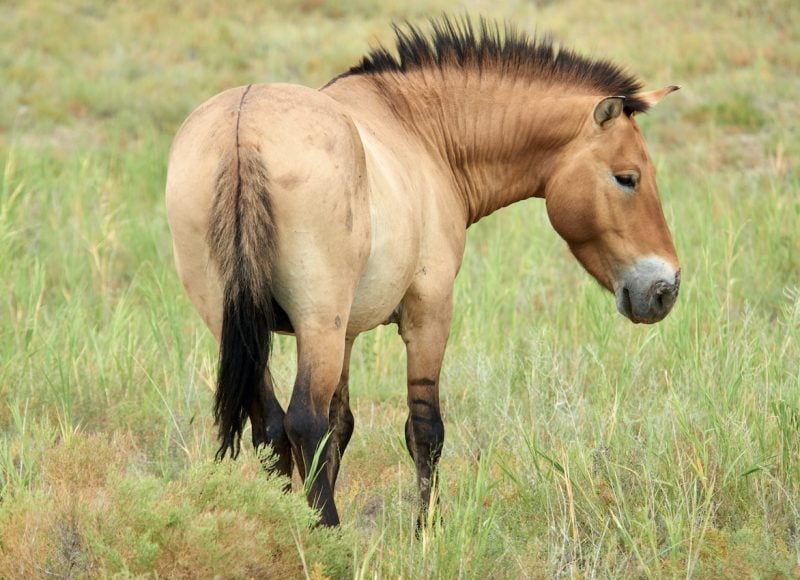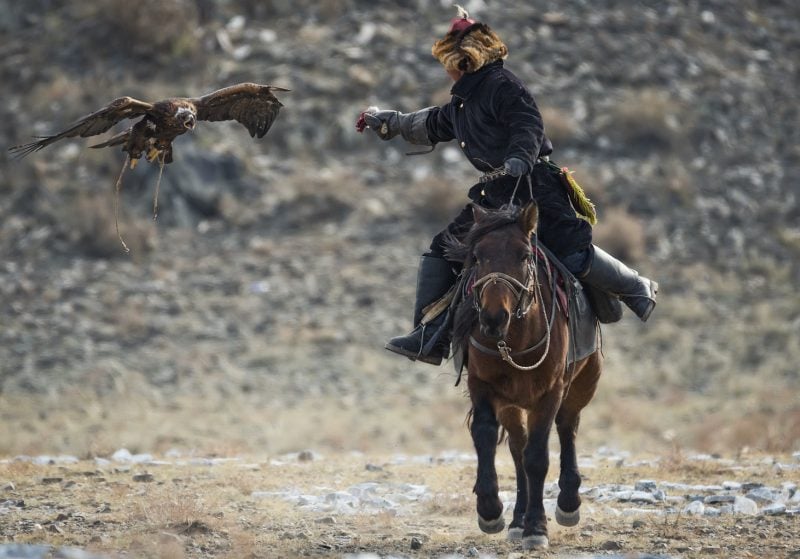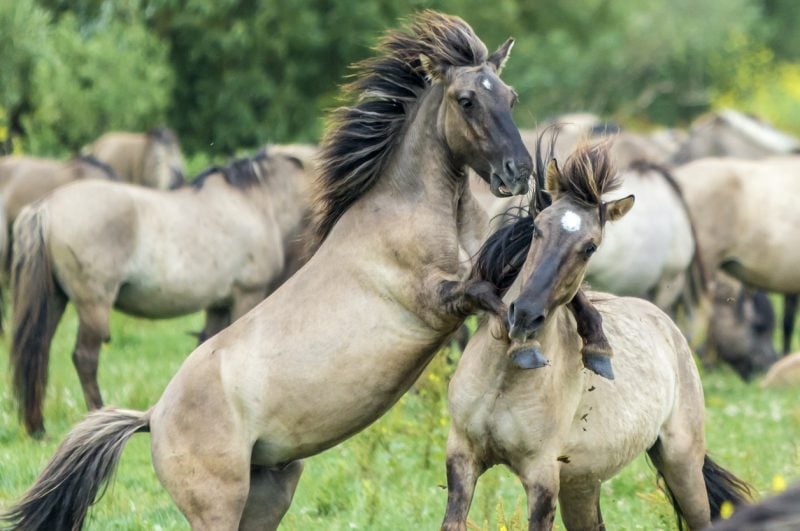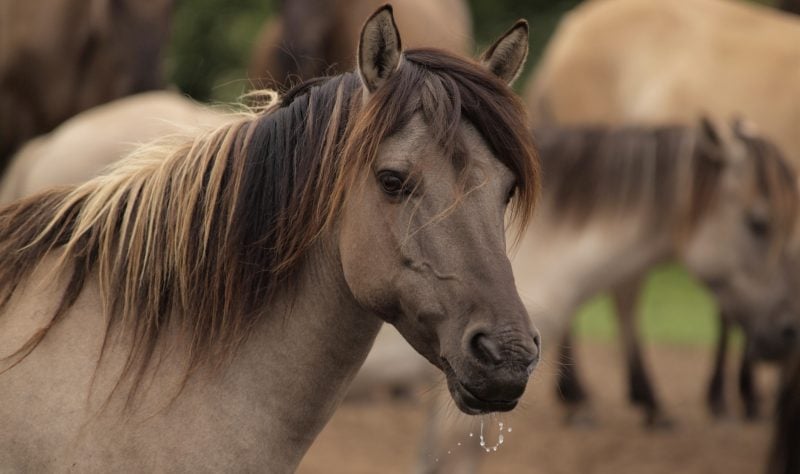The largest non-human genome project has just been completed and guess which other earthling species they focused on? Horses! My brother is a medical geneticist so he shot me this study the moment it crossed his desk. He titled his email: “Horse genetics – sad”
And yes, unfortunately, I have some rather sad news for those of us who love this species. But there are also some really cool pieces of interesting information that came to light as scientists pulled DNA from Equus bones up to 43,000 years old. So let’s start with the good stuff…
The study, Tracking Five Millennia of Horse Management with Extensive Ancient Genome Time Series, discovered that mules have been bred since at least 2200 years ago. This is remarkable because it shows that the mule genetic traits of sure-footedness, disease-resistance, and being hard working, were desirable enough to make up for sterility (which made the animal more costly).
And speaking of ancient horses… you may already know that domestic and Przewalski’s horses are the only two surviving horse lineages alive on the planet. However, this equine genome project made a startling discovery when they examined three horse bones from 5,000 – 43,000 years ago. The bones showed “morphological affinities” to another extinct equine breed, known as Equus lenensis. Raise your hand if you’ve never heard of Equus lenensis before!

They then discovered that Equus lenensis made contact with another previously unknown lineage in the Siberian Islands about 33,000 years ago, which resulted in some mingling of genes – but they have no idea what this other lineage is, or where it came from, so they just refer to it in the study as a “ghost lineage”.
Ancient ancestors of modern breeds
DNA shows that certain modern breeds native to Europe (like Friesian, Connemara, Sorraia and Duelmener), belonged to another clade (group that shares a common ancestor) that first showed up in Croatia at the same time the Arab raids on the Mediterranean coasts (including Croatia) were at their peak, around the 9th century. The earliest identification of this particular clade was in two Sassanid Persian horses from Iran. So as the Islamic conquests spread across Europe and Asia, so did the bloodlines of the Arabian horse.
Meanwhile, other horses in northern Europe (Aukštaičiai, Lithuania) did not belong to this clade. Instead, these northern European horses formed a sister clade with Pictish horses from Britain, Viking horses, and one Estonian horse – and these genes show up in the modern Shetland and Icelandic ponies. Icelandic horses are valued for their special tolting gait, which is a more comfortable four-beat gait for riding long distances than either a trot or pace gait. I highly recommend the book, A Good Horse Has No Color: Searching Iceland for the Perfect Horse by Nancy Marie Brown if you want to learn about Iceland or the breed. But getting back to our genome study, here’s another cool piece of data:
“The DMRT3 allele [genetic marker] that causes ambling and improves speed capacity in Icelandic horses was first seen in a Great Mongolian Empire horse (TavanTolgoi_GEP14_730) and slowly gained in frequency thereafter.”

The recent decline of Equus
Now for the sad news… After tens of thousands of years of genetic diversity – remember diversity builds strong, hardy, disease-resistant, intelligent species, communities, ecosystems and planets – the last 200 years of humans breeding horses paints a less rosy picture.
Genetic markers show a 16% reduction in the diversity of horse breeding stock within the last few centuries – which tracks alongside significant changes in agricultural practices of maintaining only a small breeding stock of stallions. This reduction of genetic diversity among breeding stock increases the rates of genetic mutation; which can result in an increase in disease and disability.
In the last 200 years, breeding practices narrowed to focus on very few types of temperament, traits, conformation etc. considered to be ‘desirable’. The modern penchant of breeding for certain ‘desirable’ colors or coat patterns further concentrates these potentially damaging genes. Concurrently, modern breeding practices have greatly reduced the chance of being able to eliminate these “deleterious variants from domestic horse stock” – because they’re now present in most horses.
As the number of stallions has greatly reduced, this has also limited Y chromosome diversity. The Y chromosome is enriched in genes that influence sperm count, number and sperm activity. The rise to dominance of specific stallion lines post-Renaissance is alone responsible for a 10-fold drop in Y chromosome diversity. Certain genetic alleles involved in racing (MSTN and PDK4 and ACN9) rose in frequency in the last 1100 years, showing that breeders increasingly selected for fast horses. In fact, from the Middle Ages onward, Arabian genes were present in most stallions.

I mean, who doesn’t love the speed, intelligence and emotional responsiveness of the Arabian horse? But the way biodiversity works, is that the broader the spectrum of variety, the more resilient is the ecosystem, the forest, the species, the planet. So when you reduce diversity because there is not enough land for a species to naturally migrate, mix genes and breed according to their body wisdom (or evolutionary drive), and the majority of breeding is done by us narrow-minded humans, who just want fast, beautiful, or battle-worthy horses, you get results like this:
“Most strikingly, we found that while past horse breeders maintained diverse genetic resources for millennia after they first domesticated the horse, this diversity dropped by ∼16% within the last 200 years. This illustrates the massive impact of modern breeding and demonstrates that the history of domestic animals cannot be fully understood without harnessing ancient DNA data.”
The study authors suggest that due to this accumulation of undesirable genetic traits in modern horses, future studies should look at whether veterinary medicine is able to limit the impact of these harmful genetic variants.
It’s a grim picture as human expansion shrinks wild land to the point that most of us are trying to reduce horse breeding – so that less horses are sent to slaughter. But this study is also a call to those still involved with breeding, or with conservation, to hold the issue of genetic diversity paramount.
I recently read a memoir by the famous Arabian breeder, Sheila Varian. In the book she talks about how the other breeders in California were doing a lot of line breeding (inbreeding) to produce horse after horse that looked a certain way. They weren’t considering the totality of the horse; quality of temperament, personality, physical skills, health, or capability. They simply wanted to breed/sell horses that looked as cookie-cutter as possible. Sheila was one of the first breeders to import stallions from Poland.
Conserving genetic diversity in equines
At least there are still some pockets like this last remaining feral herd in Germany of the Duelmener horse (Dülmener) The yearling stallions are culled annually (since 1907) and sold to be used as children’s ponies or carriage horses – in this way, they make sure the herd numbers do not exceed the conservation land.
Equine ethologist Lucy Rees has been instrumental in preserving a feral herd of Basque Pottokas in Spain – population excess is also culled so the horses can remain self-sustaining on the available land. And the UK has a few free-roaming feral horse preserves.

Even Russia has realized the vital contribution feral horses make to an ecosystem as 6 Przewalski horses have been released into a reserve in Orenburg:
“The reintroduction program was the brainchild of the Severtsov Institute of Ecology and Evolution at the Russian Academy of Sciences, and the Orenburg Reserve. Its steppe territory is the historic home of the Przewalski horse, and the steppe needs this horse to survive, literally.
“In steppe ecosystems these animals contribute to their recovery,” said Olga Pereladova, the head of the World Wildlife Fund’s Central Asian program. “If horses are not grazing in the steppe it deteriorates because vegetation is not trampled; overabundance of grass can cause fires.”
According to the Severtsov Institute, it is important not only that the horses have adapted to the new conditions of the Ural steppes, but also that they do not mix with farm-raised horses when stallions expel competitors from the group.
Because if that were to occur, the unique gene pool would be lost. So the Przewalski horses have been initially placed in a fenced-off reserve, allowing for enough time to pass until a stable population capable of existing under natural selection can be formed. What might that magic number be? The Institute figures it is “necessary to have 1,000 horses, with half being of reproductive age.”
Oh how wonderful it would be to have 300,000 acres of protected land and put family herds of the most genetically diverse horses left on this planet together, where they can interbreed and create more genetic diversity in Equus caballus. Wouldn’t that be amazing! Ted Turner or John Malone, are you listening…?


Jini Patel Thompson is a natural health writer and Lazer Tapping instructor. She began riding at age 2 in Kenya, and got her first horse at age 8 in Alberta, and so continues a life-long journey and love affair with these amazing creatures.








You are calling ancient horses Arabian…a breed that did not exist before 600 AD at the earliest….Persian horses predate Arabians by at least 1500 years…you added romance to your report but corrupted truth
If you click through to the study, you will see that the study authors use this nomenclature, specifically:
Also important to note is their definition of ‘modern’ or ‘recent’ breeding practices – we’re not talking about just the last century 😉
I apologize for this, I don’t have a genetics background. From what I see in the study the Arabian is pretty far down on the phylogenic tree in relation to the Sassanid Persian horse. Why would the Arabian haplogroup be in most modern studs? Thanks
https://marlin-prod.literatumonline.com/cms/attachment/0974f193-ccc0-4f26-96af-8a935d9e723a/gr3.jpg
Yeah me neither! But I did find this that may shed some light:
“A new haplogroup is born when a very specific new mutation occurs. All descendants will carry that mutation. That mutation defines that haplogroup. So if a new haplogroup is born today, we wouldn’t know it was a haplogroup until hundreds or thousands of years later when we see that lots of people have this same mutation from a single individual.”
Source: https://dna-explained.com/2013/01/24/what-is-a-haplogroup/
Would be very interested in where the Cleveland Bay sits in the Clads.. firstly as there is some evidence that the CB was the result of breeding from the Roman Cavalry at Hadrians Wall.. As the Roman Cavalry I believe largely was resourced from the Caucasus Mountains.. Also as the Byerley Turk and a few other Turk horses were influential in the later breeding of CBs .. in this respect similarly to TBs but the purpose of breeding wasn’t speed but general utility ..
I had never heard of the Cleveland Bay and had to look it up! It seems that most of the breeding lines follow the wars of the time… which makes sense. Otherwise, why would humans roam far and wide – or perhaps as they roamed for adventure, they were caught up in battles with the local humans, since we’re all pretty territorial creatures. There is a TON of info and diagrams in that report – perhaps if you took a couple hours and really combed through it, you could find out…
A fascinating & thought provoking genome study of the horse.
It gives modern people of today an opportunity to preserve & protect wild horse herds, wherever they are on our Earth. In my opinion it it vital that the ‘decision makers aka political parties’ are apprised if this information.
I agree that the practice of line breeding is & has been proven a disaster, not only for the horse but also for smaller domestic animals for example the dog or cat & other species.
Nature must be left alone, protected & any over populating will be addressed by the natural attrition of nature.
It is man’s interference that is at the root of the modern day health & environment problems.
Recovery begins now – today.
This is my opinion.
Kim
Equine Naturopath & shaman
So very true Kim. Anyone with enough money to buy even 10-20 acres and protect it for wildlife can contribute to this effort. And if not, then donate money to reliable organizations like the Rainforest Trust who can put all our small amounts of money together to purchase land in key ecosystems. Go take a look at their homepage – it’s so inspiring!
https://www.rainforesttrust.org/
Walking horses are the best example… every single one has ONE STALLION in their pedigree.
When I started riding them, was told its line breeding… wtf? In people we call that INCEST and there’s a reason we discourage breeding with your cousins. Ugh.
I did not know that! But I remember the first time I had line breeding explained to me and my response was very similar to yours. Us funny humans, we just call something another name and that makes it okay, right?? Again, our species’ tragic inability to think long-term or wholistically.
I recently purchased a LLCIP gelding.( Lac la Croix Indian Pony) now known as the Ojibwe Horse.
It is endangered in North America but there in an effort to save this breed by breeding farms and rescue farms. It is known as a semi feral pony but with its great mind and kind temperament, it is making its mark as carting and children’s show ponies.
There are thought to be around 250 ponies left. Can you tell me more about them.
Hi Joanne – did you see that Lesley gave us some more info about the Ojibwe horse here? She also has a nice website set up with even more info:
http://ojibwehorse.ca/
I work with a critically endangered native Canadian breed, the Ojibwe Horse. DNA studies have shown that they belong to the rare and, I understand, ancient E haplotype. Because there are so few of them (<200) they are rarely included in these large scale genome studies. Indigenous peoples' oral histories suggest this breed may date back thousands of years possibly even to the last ice age. They exhibit cold weather adaptations found in very few other breeds.
So interesting! Thanks so much for sharing Lesley 🙂
Is there any mention of the Konik in the study?
Not that I saw. But there is this mention of the Tarpan (from which the Konik descended):
“Interestingly, Upper Paleolithic cave paintings in Europe have often been proposed to depict Przewalski’s horses due to striking morphological resemblance (Leroi-Gourhan, 1958). Our sample set included one horse from the Goyet cave, Belgium dated to ∼35,870 years ago. Although characterized at limited coverage (0.49-fold), D-statistics revealed closer genetic affinity to IBE and DOM2 than to the ancestors of Przewalski’s horses (−15.5 < Z scores < −2.4). European cave painting is, therefore, unlikely to depict Przewalski’s horses. It may instead represent the ancestors of the Tarpan, assuming that this taxonomically contentious lineage neither represents domestic horses turned feral nor domestic-wild hybrids but truly wild horses that went extinct in the late C19th (Groves, 1994)."
Thanks for sharing your thoughts. I’m an equine photographer and currently working on “Forgotten Horses”, a project dedicating to all rare and endangered horse breeds. I’m trying to find official numbers in my research and I’m looking up breeds on the FAO Domestic Animal Diversity Information System (DAD-IS).
It is a sad fact, if you follow the FAO biodiversity report on livestock, that 7 745 local breeds of livestock are still in existence, 26% of these are at risk of extinction, the risk status of 67% is unknown and only 7% are not at risk (!!!!)
You can match this report almost 1:1 to equines: almost 2/3 of the global population has unknown statuses, only a few are safe and the rest is endangered. The ones that are not at risk, these ~7% are the same popular and well promoted few breeds with the biggest populations and probably also less genetic diversity. (https://thepixelnomad.com/discover/forgotten-horses/)
Even I’m still researching and collecting material about this topic, it isn’t easy to find reliable data about it. In case you know more, I would love to hear from you.
I’m also having a project about “Free Horses”, which refers to any feral, semi-feral or seasonal free roaming domestic horse breeds (https://thepixelnomad.com/discover/free-horses/). Unfortunately the intersection to Forgotten Horses is very high and almost all populations of Free Horses are also endangered.
The list of endangered horses is very long. and as the populations of all these unpopular horse breeds get smaller, the already small gene pool in these breeds is shrinking and causes big losses in equine diversity.
WOW! I adore your projects and your photos are simply stunning!! I simply LOVE LOVE LOVE that you’re doing this. Are you interested in doing a Guest Post (with your fabulous photos) for our blog? That would help spread the word about your fabulous work. Email me if that sounds like a good idea 🙂
I have Followed you on Instagram to stay updated and I really like the explanations/info you give with your posts. If anyone else reading this would like to follow Cécile on Instagram:
https://www.instagram.com/thepixelnomad/
Thank you for your kind words! sounds like a good plan!
Ooooh just came across this – check it out:
https://livestockconservancy.org/index.php/what/internal/endangered-equine-alliance
Perhaps they could assist in your filmmaking project??
The Galiceno is a perfectly proportioned small horse with a big heart, descended from the original horses brought by Cortez on his journey to the Anericas. Yet it is now critically endangered, and there are only 150 left. The horses have an unusually kind temperament, making them very suitable for children and adults alike.
Another breed I have never heard of! Thanks for sharing with us 🙂
AND came across this very interesting resource while looking up the breed:
https://livestockconservancy.org/index.php/heritage/internal/galiceno
Interesting stuff.
I own two quite different breeds, but likely the same Clade as the Icelandics — since both are gaited. A Paso Fino, and a Rocky Mountain Horse.
Now… I live in France, and here they are super ultra rare. I know the RMH is on the “Threatened” list (fewer than 5000), so to me it’s quite interesting to see the genomes and how they developed.
The RMH pretty much all trace back to one stallion (Old Tobe), so there is/was tons of inbreeding going on.
Sadly, it seems they are often bred just for color.
Well that’s the thing though isn’t it – when you see absolutely stunning creatures like this one, you so want MORE! And financially for the breeder, you will sell more and can charge more.
Perhaps the most important thing – as humans expand and land shrinks – is to set up sanctuaries to maintain the gene pool for the future…